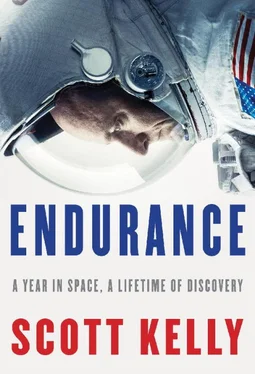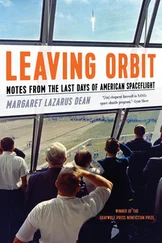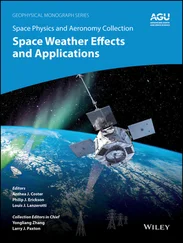I was put in charge of the caution and warning system on the space station, which sounds pretty important until you consider the fact that the space station didn’t yet exist. I was trying to learn as much as I could about the space shuttle, because it was the vehicle I was preparing to fly. For the pilot and commander, there are so many seemingly insignificant errors that could result in the loss of the vehicle and crew—it was the most important thing for me to learn not to make those mistakes. So the space station was going to take a backseat in my mind.
Some of us were also assigned to phases of flight to gain a special expertise—in my case, the rendezvous phase. I was pleased with that, because I knew there was a good chance I would fly a mission that would rendezvous with a space station or a satellite someday, and this way I would be well prepared. I would receive rendezvous training well ahead of my classmates, which would have ramifications going forward.
The Astronaut Office was a busy place in those days with such a large new class adding our numbers to the already existing corps. Some very experienced astronauts were still around, and it was an honor to serve along with them. John Young, the Gemini-era astronaut who had been on my selection committee, was always in the astronaut gym, putting everyone to shame just by showing up. Another spaceflight legend, John Glenn, was assigned to his space shuttle flight not long after I became an astronaut. One day I had four-year-old Samantha with me at work because Leslie had a dental appointment, and as I was walking her around I saw Glenn working diligently in his office. I introduced myself and Samantha.
He looked up and said, “Hi, young lady. What are you doing today?”
“I’m going to lunch with my dad,” Samantha answered.
“What’s your favorite food?” he asked her.
“Macaroni and cheese,” she said.
Senator Glenn gave her a look of pleased surprise. He held up the papers he had been working on.
“Look right here,” he said. “I was just selecting my space food for my mission and I just wrote, ‘Macaroni and cheese.’ That’s my favorite, too!”
Another time, I had Samantha with me at a party, and I encouraged her to talk to John Young about his experience walking on the moon. Samantha approached him and said, “My dad says you walked on the moon.”
John responded, “I didn’t walk on the moon. I worked on the moon!”
More than a year later, we were watching a documentary about Apollo, and I pointed out John Young to Samantha. “You met him, remember? He walked on the moon.”
Samantha didn’t miss a beat: “Daddy, he didn’t walk on the moon, he worked on the moon.”
John Glenn completed his mission, in October 1998, after which I inherited his parking space and used it for the next eighteen years.
Leslie and Samantha took easily to life in Houston. Leslie was always good at making new friends, and she quickly became part of a tight circle of women in our neighborhood. I would often come home from work to find a group of five or six women clustered in the kitchen, drinking wine and eating cheese, talking and laughing. She also became the head of the astronaut spouses’ group, which was responsible for planning social events for the astronaut corps, especially the traditional parties in honor of the spouses of the crew that was flying next. They also helped out with meals, babysitting, and other favors for anyone in the group who had a special need, like a death in the family or a new baby. The role suited Leslie well.
—
AS PART OF my ASCAN training, I learned to fly the Shuttle Training Aircraft (STA), a Gulfstream business jet that had been modified to re-create the approach profile and handling qualities of the space shuttle in the landing phase as closely as possible. Flight computers simulated the drag we would experience in the heavier, less agile orbiter by putting the engines in reverse while airborne. The left side cockpit and the controls had been designed to simulate the experience of landing the shuttle. The STA generally flew out of El Paso, Texas, so we would fly over there in a T-38, which took a little over an hour, get in the STA, then fly another thirty minutes to the White Sands Test Facility in New Mexico. I did many practice approaches to the dry lake bed runways in that aircraft, stopping short of actually touching the wheels down. At first, we’d fly the STA every few weeks, learning to land the space shuttle. Eventually, we moved to flying every other month, then every quarter to maintain our proficiency, until we were assigned to a real mission.
I was in El Paso one day in March 1999, just having finished my ten practice landings and getting ready to fly back to Houston, when one of the senior shuttle commanders, Curt Brown, a tall guy with a receding hairline and a thick Tom Selleck 1980s mustache, came up to me. He had only spoken to me a couple of times before. He was known to be extremely technically competent, and his experience—five shuttle missions in six years—was nearly unequaled. But he also had the reputation of being arrogant and unfriendly to those not worthy of his attention. A high flight rate, training for missions one after another, practically without a break, can also bring burnout.
“Hey, come over here,” he said sternly. “I need to talk to you.”
I followed him into a private office, wondering what I had done to piss him off. He shut the door behind us, then turned and poked me in the chest three times while staring straight into my eyes.
“You better have your shit together,” he said to me, “because we’re flying in space in six months.”
I felt a couple of different things at once. One was: I’m fucking flying in space in six months!
Another was: Wow, what a shitty way to let someone know he’s got his first flight assignment.
“Yes, sir,” I said. “I’ve got my shit together.”
Curt told me to keep this news a secret. I told my brother, of course.
A couple of days later, I was called in to see Charlie Precourt, the new chief of the Astronaut Office, along with Curt and French astronaut Jean-François Clervoy (we called him “Billy Bob” since “Jean-François” didn’t sound very Texan). Charlie looked very serious. He told Billy Bob and me that we were in trouble. A few months earlier, he said, we had screwed up on a T-38 flight and had drawn a flight violation from the FAA.
Because of my run-in with Curt earlier that week, and knowing that we were being assigned to a flight, I had a strong feeling that he and Charlie were just messing with us. Billy Bob didn’t know that, though, and all the color drained from his face. Once Curt and Charlie had had enough fun, Charlie said, “We’re just kidding, guys. You’ve both been assigned to STS-103 on Discovery. It’s going to be an emergency repair mission to the Hubble Space Telescope.”
Billy Bob was visibly relieved. Curt would command the mission, and we would be joined by John Grunsfeld, Mike Foale, Steve Smith, and Claude Nicollier. I was to be the only rookie on the crew and the first American in my class to fly. The primary goal was to fix the failing gyroscopes on the Hubble Space Telescope on four spacewalks, each more than eight hours long. Hubble needs at least three of its six gyroscopes to be working in order to make precise observations, and three had already failed.
The Hubble Space Telescope has been making observations of the universe since 1990. Until then, astronomers could never get a truly clear view of the night sky because of the distorting effect of the atmosphere, the same effect that causes stars to appear to twinkle. Observing stars and galaxies through the filter of our atmosphere was like trying to read a book underwater. Putting a telescope in orbit outside the atmosphere and past the reach of light pollution has changed the field of astronomy. By observing distant stars, scientists have been able to make discoveries about how fast the universe is expanding, how old it is, and what it is made of. Hubble has helped us to discover new planets in new solar systems and confirmed the existence of dark energy and dark matter. This one scientific instrument has revolutionized what we know about our universe, and the task of repairing it—which always brings the risk of damaging or even destroying its sensitive components—is an enormous responsibility.
Читать дальше












